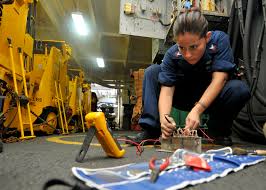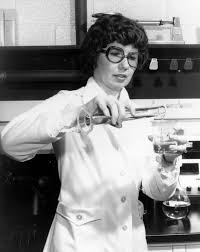 It has been a recurring topic why women are not as involved in STEM (abbreviation for Science, Technology, Engineering and Mathematics) as men. Although women represent 60% of college graduates, taking the number of undergraduate degrees earned in 2014-15, their representation in STEM is only 35%. Unfortunately, the number of undergraduate degrees handed out has increased in total in the last decade but the gender gap did not decrease, given it was 35% in 2008-2009 as well. This is not just a local phenomenon, in Europe as well, only four countries were able to state that at least 15% of all STEM graduates are female.
It has been a recurring topic why women are not as involved in STEM (abbreviation for Science, Technology, Engineering and Mathematics) as men. Although women represent 60% of college graduates, taking the number of undergraduate degrees earned in 2014-15, their representation in STEM is only 35%. Unfortunately, the number of undergraduate degrees handed out has increased in total in the last decade but the gender gap did not decrease, given it was 35% in 2008-2009 as well. This is not just a local phenomenon, in Europe as well, only four countries were able to state that at least 15% of all STEM graduates are female.
The gender gap is not equal in all fields. While 35.2% of chemists are women, the percentage of engineers is only 13% in the United States. Also within engineering, there are fields where the gap is even greater, mechanical engineering being one of them where the representation of women is only 7.9%. Computer science is also severely male dominated, women earn 18% of all undergraduate computer and information sciences degrees according to the National Center of Women & Information Technology. Interestingly, between 2004 and 2014 the proportion of women receiving engineering or computer science degrees actually decreased. Let us note, that it is even harder for women of minorities: Black and Hispanic women make up about 1% of the engineering workforce, American Indian and Alaska Native women only a fraction and the statistics are not much better within computer science either.
Facts are facts, there are more men than women in these professions. One might ask why this is considered an issue? The importance of finding the reason why women tend to avoid STEM becomes more clear when reading the prediction of The American Association of University Women in which they state, that “in less than 10 years, the United States will need 1.7 million more engineers and computing professionals”. The need for STEM workers is there and in order to continue developing as a country this demand should be met.
Knowing that within STEM engineers will be in demand, let us examine how a balance in this specific labor market can be achieved.
The question is how can we make engineering more appealing to women. Or at least this is the first thought that comes to mind. According to research conducted on the topic though, the issue is more complex than answering the previously mentioned question. Women not having an interest in whatever engineering careers have to offer is not the main issue. In order to make it clear what the solution could be, let us clarify the actual causes of female under-representation among engineers.
 Stereotypes
Stereotypes
Saying that stereotypes are one of the main reasons most women chose a career path might sound like a cliché, but then again, clichés are what stereotypes are all about. We consider our society to be modern and accepting but we still think of engineering as a “man’s job”. When picturing a successful engineer, we usually have a man in mind, no matter what our gender is. The severe sexism women still have to face in STEM was proven in a study by showing 100 science faculty members two resumes with the same qualifications, the only difference of one being a resume of a male, the other a female. The male candidate was considered to be more competent and hirable and preferred over the female candidate by most faculty members.
 Role Models
Role Models
Heather R. Huhman, a contributor of Forbes in 2012 asked the question “Where is the female equivalent of Steve Jobs or Mark Zuckerberg?” One can hear about many modern STEM role models in the new, but unfortunately, not many of them are women. Young women rather see women in stereotypical female roles and don’t become familiar with successful female engineers and their stories. Sivan Aldor-Noiman, Director of Data Science for the Data Science, Center of Excellence, The Climate Corporation who in an industrial engineer said in one of her interviews one of the difficulties young women have to face is because when “looking at the top it’s very hard to picture themselves there because they don’t see a good role model”. Of course, this is a vicious cycle: the lower the number of female engineers, the fewer role models there can be which again will result in fewer female engineers.
Discrimination
As mentioned before, 13% of practicing engineers are women, but among engineering graduates, women represent 20% which means, that many women decide to leave the field after receiving their degrees. According to the Society of Women Engineers, one of four female engineers leaves engineering while for men this rate is only 10%. In a research reported by the Harvard Business Review, two-thirds of the women who work in STEM reported having to prove more evidence of competence, co-workers undermining their capabilities. This is just one type of discrimination women face, many also stated they were mistaken for administrative or custodial staff. While one could assume that the wage gap also plays a role in women leaving the sector, Scientific American states within science and engineering this is not the case. There’s really no need to search for further reasons, it is understandable that if regularly mistreated at work, one decides to leave, regardless of the possible drop of income or the inconvenience of the shift.
Being aware of the previously mentioned causes of female under-representation in engineering, which you can also see in the infographic below, we get one step closer to reducing the gender gap. Not only is it important for society as a whole to employ more women, but it is also the right choice when keeping personal gain in mind: By a research conducted by McKinsey & Company, highly gender-diverse companies are 15% more likely to financially outperform their respective national industry medians.
Each reason can be targeted separately and while the issue is pressing, it will take time and energy to reach actual gender equality. The fact, that several organizations like Engineering is Elementary, Girls Who Code and the Society of Women Engineers are working on solving the issue is a great advancement but the more it is talked about, the faster the change can be achieved. If not able to do more, we can all get engaged in conversations about the issue and help female and male STEM professionals overcome their outdated mindset according to which STEM is “rather a man’s job”.























